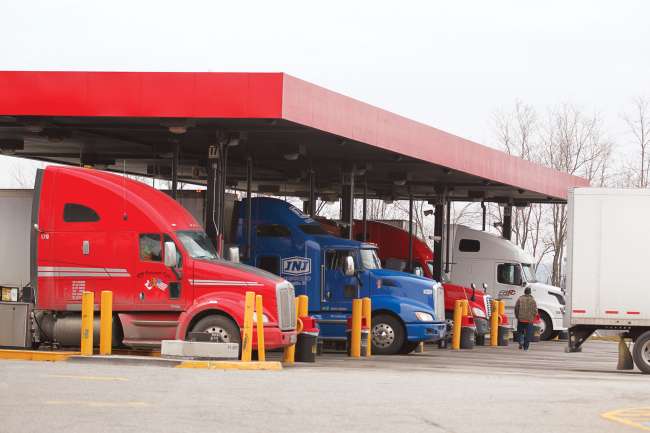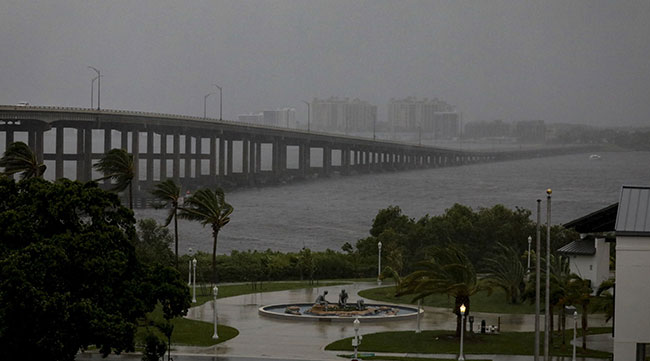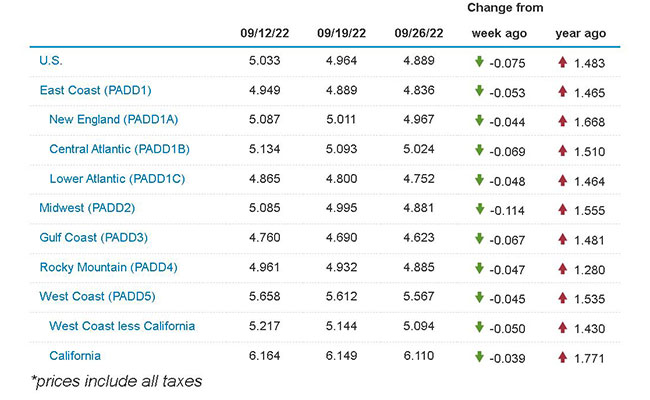Diesel Falls 7.5¢ to $4.889 a Gallon

[Stay on top of transportation news: Get TTNews in your inbox.]
The national average price of diesel fell 7.5 cents to hit $4.889 a gallon, according to Energy Information Administration data released Sept. 26.
Diesel’s fourth consecutive decline — totaling 22.6 cents — pushed the price for a gallon below $4.90 for the first time since it cost $4.849 on March 7.
Trucking’s main fuel still costs $1.483 more for a gallon than at this time in 2021.
The price of diesel fell in all 10 regions EIA surveys, ranging from a high of 11.4 cents in the Midwest to a low of 3.9 cents in California, where the price of a gallon costs $6.11.

Ominous skies shroud the Caloosahatchee Bridge in Fort Myers, Fla, on Sept. 27, ahead of Hurricane Ian's arrival. (Eva Marie Uzcategui/Bloomberg News)
One oil market analyst said Hurricane Ian’s impact on fuel prices would be minimal as it was not expected to disrupt drilling infrastructure further west in the Gulf of Mexico or refining operations inland.
“At this point, it does not look like it’s going to do any major damage to the export terminals, either,” he added.
EIA reported the United States exported about 0.33 billion barrels, or 14.04 billion gallons of ultra-low-sulfur diesel in 2021.

Flynn
The major storm, after crossing Cuba, was building into a Category 3 and bearing down on southwest Florida on Sept. 27, and then was forecast to move up the state into portions of the Southeast.
“The dollar seems to be blowing the oil market around more than this tropical storm is going to,” Phil Flynn, senior energy analyst at The Price Futures Group told Transport Topics on Sept 27.
Experts noted commodity prices rise and fall with the U.S. dollar, with which they are priced.
EIA reported the West Texas Intermediate oil futures price was $76.71 per barrel on Sept. 26. That was down $9.02 compared with a week earlier.
The price of a barrel of oil accounted for 45% of the retail price for a gallon of diesel and 57% of the retail price of a gallon of gasoline.
Our U.S. Energy Atlas pulls data from multiple sources to provide a customizable view of U.S. energy infrastructure in the forecast path of Hurricane #Ian. https://t.co/icnF8JnxbT pic.twitter.com/KITzLTA5xG — EIA (@EIAgov) September 27, 2022
Meanwhile, the national average price for a gallon of gasoline rose 5.7 cents to settle at $3.711, which is 53.6 cents more than it cost at this time a year ago.
AAA reported the national average price for gas rose on tight supply and fluctuating oil prices. Gas is a primary fuel used especially by medium-duty commercial fleets.
A still-lingering potential disruptive factor on fuel prices is the threat of a rail strike that has been averted for now through a tentative agreement.
“No one has actually seen the final language. So right now it is sheer speculation on the part of the rank and file as to is this good, is it bad or is it ugly. So a strike is still possible because the rank and file have the last word. And that vote will not come for some time yet,” Ron Kaminkow, general secretary at Railroad Workers United, said in a recent television interview.
Great insight from AFPM’s Vice President of Petrochemicals and Midstream @benerg03 on how critical the rail industry is to a lot of supply chains and why we need to improve service. https://t.co/FkkyWyPJ0g — AFPM (@AFPMonline) September 20, 2022
According to trade group American Fuel & Petrochemical Manufacturers:
• Refineries need consistent rail service to maintain operations. If railcars aren’t coming in regularly to pick up facility products, including the sulfur that refiners remove from crude oil, production will have to curtail. If sulfur cannot be moved out, for example, crude refining cannot continue at the same pace.
• About 300,000 barrels of crude oil move by rail each day, volume that could supply about two midsize refineries. Other critical feedstocks, chemicals and additives — such as isobutane for gasoline production and water treatment chemicals including chlorine — are delivered daily by rail. Some regions, because of limited pipeline capacity and inadequate trucking alternatives, have no option apart from rail to receive these essential deliveries.
U.S. On-Highway Diesel Fuel Prices

EIA.gov
At the same time, Hurricane Ian is poised to hit the nation’s production of phosphate fertilizer, threatening supply as the cost of growing food in the U.S. rises by the most ever, Bloomberg News reported.
Florida is home to Mosaic Co.’s phosphate rock assets, where they mine product, and to facilities where they turn that rock into fertilizers such as diammonium phosphate and monoammonium phosphate, commonly known as DAP and MAP.
Mosaic’s New Wales plant is “right in the middle of the damage swath,” Chuck Watson, a disaster modeler with Enki Research, told Bloomberg. He added that the facility could be out for weeks.
After the storm, emergency supplies are trucked in, and inbound rates shoot up, at least for a while, DAT Solutions noted. Van and refrigerated freight move in first, followed by flatbeds hauling construction equipment and materials.
Want more news? Listen to today's daily briefing below or go here for more info:

